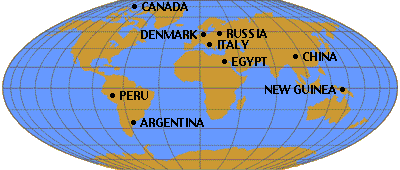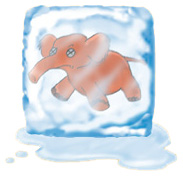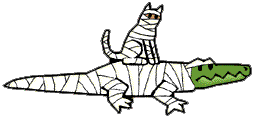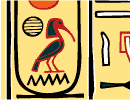|
All About Mummies
Special thanks to Neferkiki for this wonderful introduction
What is a mummy?
When a person or animal dies, bacteria on the body causes it to decompose,
eventually leaving just the skeleton behind. But sometimes, if the conditions
are just right, a body will be mummified instead. A mummy is any dead body where
the fleshy parts have been somehow preserved. Mummies are found all over the
world, and have been preserved in a variety of ways. Sometimes they are
mummified accidentally by nature, and sometimes they are mummified intentionally
by humans. Although there are many different types of human and animal mummies,
the one thing they all have in common is that somehow bacteria was prevented
from causing the body to rot.

some of the places around the world where mummies
have been found
Sometimes, the forces of nature can stop bacteria from rotting a corpse.
Extreme cold can prevent (or at least slow down) decomposition. In 1984,
scientists discovered the mummies of three English sailors in the Canadian
Arctic. These bodies were in such good shape that one of the scientists remarked
that they looked like they were still alive, just unconscious. But these sailors
have been dead for about 150 years!
Another famous frozen mummy is "the Ice Man," who has the prestige of being
the oldest well-preserved human mummy in the world. How old? About 5,300 years!
Hikers found him frozen in a glacier in the Alps near the border of Italy and
Austria. By studying his body and the clothing and tools that were found with
him, scientists are trying to figure out who the Ice Man was and how he lived
and died.
The Ice Man may be the oldest frozen human mummy, but there is a frozen
animal mummy that's even older. In 1977, a mummified baby woolly mammoth was
found in ice-- it had died 30,000 years ago!

Mummies are sometimes created accidentally by nature in bogs. A bog is a
marshy wet area that is filled with peat moss. Even though a bog is not cold
like the Arctic or the Alps, a dead body thrown into a bog can still be
preserved. Bacteria needs oxygen as well as warmth, but the densely-packed peat
creates an oxygen deficient environment that prevents bacteria from causing
decay. Bog mummies are pretty nasty to look at-- their skin is blackened and
leathery and they look all stretched out, as if they were made of rubber. The
best bog mummies are found in Europe, especially in Denmark. Scientists believe
that these people were killed on land, maybe as a punishment or as a human
sacrifice, and then thrown into the bog.
In addition to warmth and oxygen, bacteria also needs moisture to decompse a
corpse. In the late 1800's, the mummified bodies of people (and pet dogs, too!)
were found buried in a cemetary located in the dry desert region of coastal
Peru.
And of course, some mummies are made intentionally by humans. No matter what
mummification technique is used, a mummy is always made by somehow robbing
bacteria of at least one of the factors it needs to cause decay: moisture,
warmth, or oxygen.
The Gaunche people of the Canary Islands used to dry the bodies of their dead
and stuff them with plants. Ancient New Guineans, Colombians, and some Peruvians
would smoke-dry their dead, preserving them like beef jerky! Killing bacteria
with chemical treatments is another manner in which to preserve a body. From
1599 to 1920, Sicilian monks used a secret process to mummify the dead. Six
thousand of these mummies are on display in the catacombs of a church in
Palermo, Sicily.
Even some well-known people have been mummified in recent times. In 1952, the
body of Eva Peron (she was the wife of a former leader of Argentina, and the
subject of the movie "Evita") was preserved by a technique that involved
paraffin wax. Russian leader Vladimir Lenin was also mummified. His body is
actually on display in Red Square, Moscow!
By far, the most famous mummies are those from Egypt. The earliest ones were
created accidentally by nature, but eventually the ancient Egyptians began
creating them intentionally to go along with their belief in an afterlife.
Egyptian mummifying techniques evolved over several thousands of years. People
weren't the only kind of mummies-- cats, crocodiles, baboons, and a legion of
other animal species were immortalized as well.

The first Egyptian mummies
 Around seven or eight thousand years ago, people began to
settle on the banks of Nile River in the area that we now call Egypt. Every year
the Nile flooded, leaving a fresh layer of fertile soil along the shore after
the flood waters receded. Beyond the fertile soil lay the barren desert sands,
so the ancient Egyptians could only grow their crops in the rich soil along the
Nile. The Egyptians weren't about to waste this precious land on graveyards, so
they chose to bury their dead in the hot desert sands instead. Around seven or eight thousand years ago, people began to
settle on the banks of Nile River in the area that we now call Egypt. Every year
the Nile flooded, leaving a fresh layer of fertile soil along the shore after
the flood waters receded. Beyond the fertile soil lay the barren desert sands,
so the ancient Egyptians could only grow their crops in the rich soil along the
Nile. The Egyptians weren't about to waste this precious land on graveyards, so
they chose to bury their dead in the hot desert sands instead.
The dead were buried unclothed in a crouched position in shallow graves. Clay
pots of food and water and some of the deceased's favorite possessions were put
in the grave with the body. It was believed that the spirit would use these
items in the afterlife. What the early Egyptians didn't realize was that the hot
dry sands naturally preserved the dead by absorbing the moisture out of the
body. Without moisture, bacteria on the bodies couldn't cause decay. This was
good news because in some mysterious way, their dead relatives seemed to still
be living. Sort of, anyway!
However, the manner in which they found this out was not good news.
The early Egyptians probably realized that the dead were preserved after
discovering that the scavenging jackals were digging up the bodies to eat.
So what's an Egyptian to do? The bodies obviously needed a more dignified
burial. One improvement was to pile rocks on the graves to keep the jackals out.
They also began lining the burial pits with straw or animal skins. Later still,
they added floors and walls made of mud bricks. These early tombs were much
better than a simple hole in the sand.

Dead kings, queens, and nobles were prepared even more carefully. Instead of
being buried without clothes, they were wrapped in linen, which is a type of
cloth made from the flax plant. To protect the body even further, melted resin
(a sticky plant extract that hardens to a varnish-like finish) was used to coat
the linen bandages. After the resin dried, the body was placed with jewels and
treasures in a tightly closed coffin and buried even deeper than an ordinary
grave.
However, these more elaborate burials were disasters, not improvements! Since
the coffin and the coating of resin and linen kept the hot dry sand away from
the corpse, the bodies decayed from within instead of becoming mummified. The
Egyptians probably discovered this when grave robbers broke into the graves to
steal the treasures. All that remained inside the stiff bandages were bones.
The Egyptians faced a dilemma. They desired elaborate burials, but wanted to
preserve the dead as well. They realized that the trick was to preserve the
bodies before burial. They experimented with different techniques and
finally discovered a method of mummification that was so effective that their
mummies are still preserved today.
|





